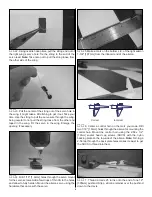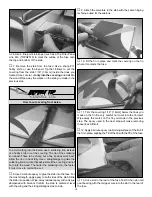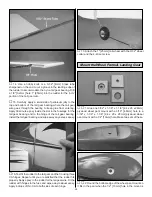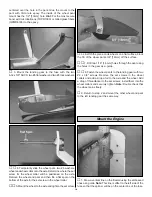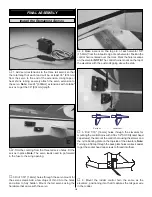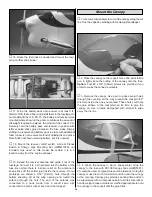
1. Use scissors or a sharp hobby knife to cut the decals from
the sheet.
2. Be certain the model is clean and free from oily
fingerprints and dust. Prepare a dishpan or small bucket with
a mixture of liquid dish soap and warm water–about one
teaspoon of soap per gallon of water. Submerse the decal in
the soap and water and peel off the paper backing. Note:
Even though the decals have a “sticky-back” and are not the
water transfer type, submersing them in soap & water allows
accurate positioning and reduces air bubbles underneath.
3. Position decal on the model where desired. Holding the
decal down, use a paper towel to wipe most of the water away.
4. Use a piece of soft balsa or something similar to
squeegee remaining water from under the decal. Apply the
rest of the decals the same way.
❏
1. Turn on the transmitter and receiver and center the
trims. If necessary, remove the servo arms from the servos
and reposition them so they are centered. Reinstall the
screws that hold on the servo arms.
❏
2. With the transmitter and receiver still on, check all the
control surfaces to see if they are centered. If necessary, adjust
the clevises on the pushrods to center the control surfaces.
❏
3. Make certain that the control surfaces and the
carburetor respond in the correct direction as shown in the
diagram. If any of the controls respond in the wrong direction,
use the servo reversing in the transmitter to reverse the
servos connected to those controls. Be certain the control
surfaces have remained centered. Adjust if necessary.
Use a ruler or Great Planes Accu-Throw
™
Deflection Gauge
(GPMR2405) to accurately measure and set the control throw of
each control surface as indicated in the chart that follows. If your
radio does not have dual rates, we recommend setting the
throws at the low rate settings. NOTE: The throws are measured
at the widest part of the elevators, rudder and ailerons.
At this stage the model should be in ready-to-fly condition
with all of the systems in place including the engine, landing
gear, covering and the radio system.
❏
1. Use a felt-tip pen or 1/8"-wide tape to accurately mark
the C.G. on the top of the wing. The C.G. is located 4-3/4"
[120mm] back from the leading edge of the wing.
This is where your model should balance for your first
flights. Later, you may wish to experiment by shifting the
C.G. up to 3/4" [20mm] forward or 3/4" [20mm] back to
change the flying characteristics. Moving the C.G. forward
may improve the smoothness and stability, but it may then
require more speed for takeoff and make it more difficult
to slow for landing. Moving the C.G. aft makes the model
more maneuverable, but could also cause it to become
too difficult for you to control. In any case, start at the
location we recommend and do not at any time balance
your model outside the recommended range.
More than any other factor, the C.G. (balance point) can
have the greatest effect on how a model flies and may
determine whether or not your first flight will be successful.
If you value this model and wish to enjoy it for many flights,
DO NOT OVERLOOK THIS IMPORTANT PROCEDURE.
A model that is not properly balanced will be unstable and
possibly unflyable.
Balance the Model (C.G.)
We recommend the following control surface throws:
High Rate (3D)
Low Rate
ELEVATOR:
2-1/4" [57mm] up
1" [25.5mm] up
2-1/4" [57mm] down
1" [25.5mm] down
RUDDER:
3-1/2" [89mm] right
1-1/2" [38mm] right
3-1/2" [89mm] left
1-1/2" [38mm] left
AILERONS:
2-1/2" [63.5mm] up
1-1/4" [32mm] up
2-1/2" [63.5mm] down 1-1/4" [32mm] down
Set the Control Throws
CARBURETOR WIDE OPEN
RUDDER MOVES RIGHT
LEFT AILERON MOVES DOWN
RIGHT AILERON MOVES UP
ELEVATOR MOVES UP
4-CHANNEL
TRANSMITTER
(STANDARD MODE 2)
4-CHANNEL RADIO SETUP
TRANSMITTER
4-CHANNEL
TRANSMITTER
4-CHANNEL
TRANSMITTER
4-CHANNEL
Check the Control Directions
GET THE MODEL READY TO FLY
Apply the Decals
21



